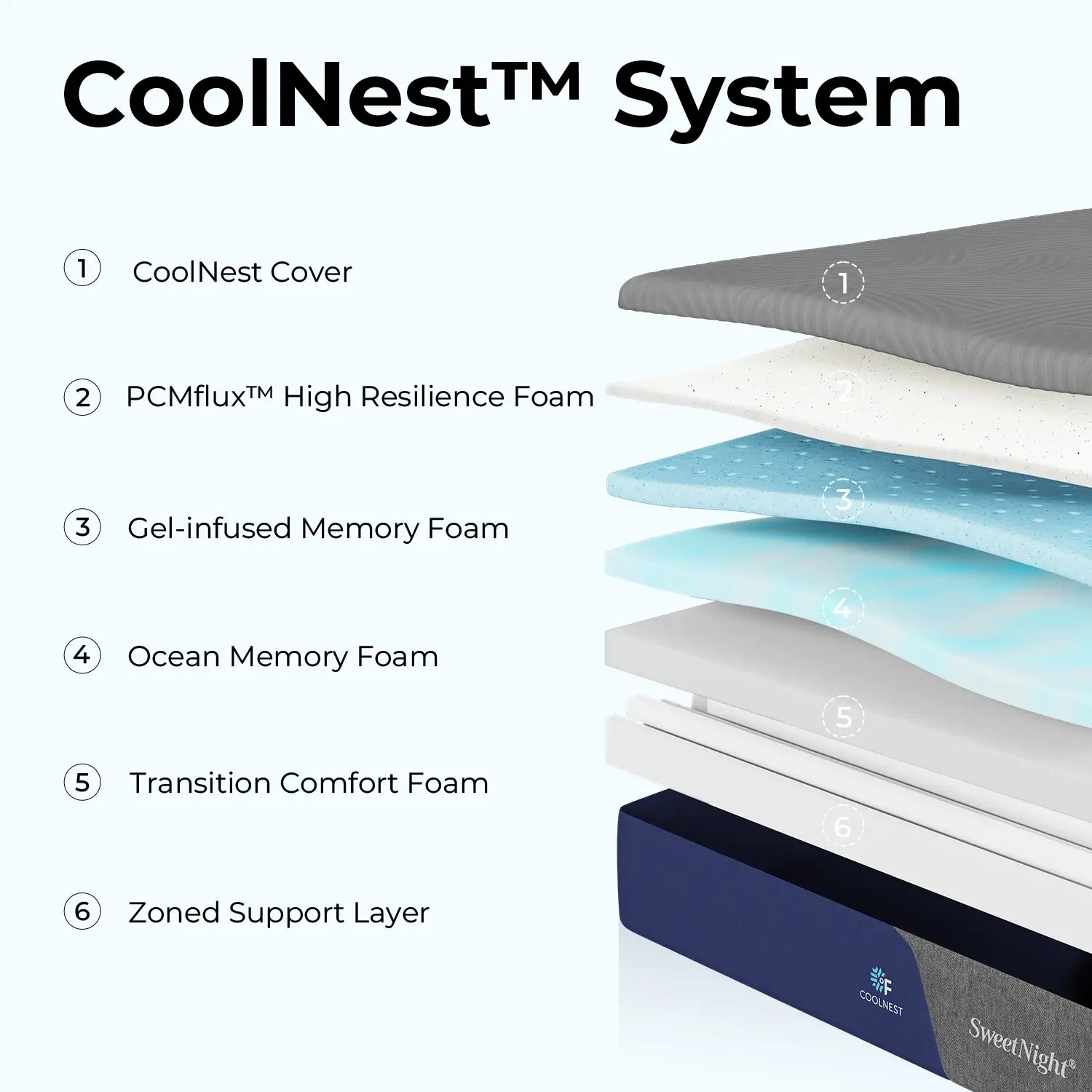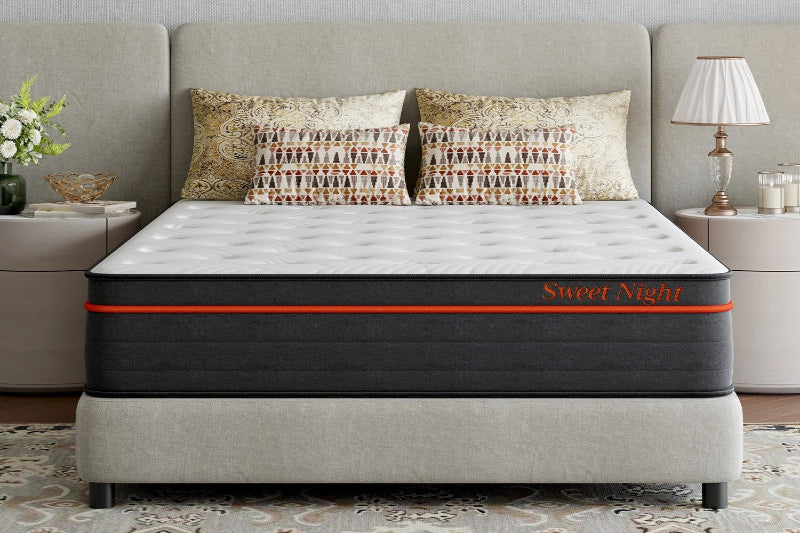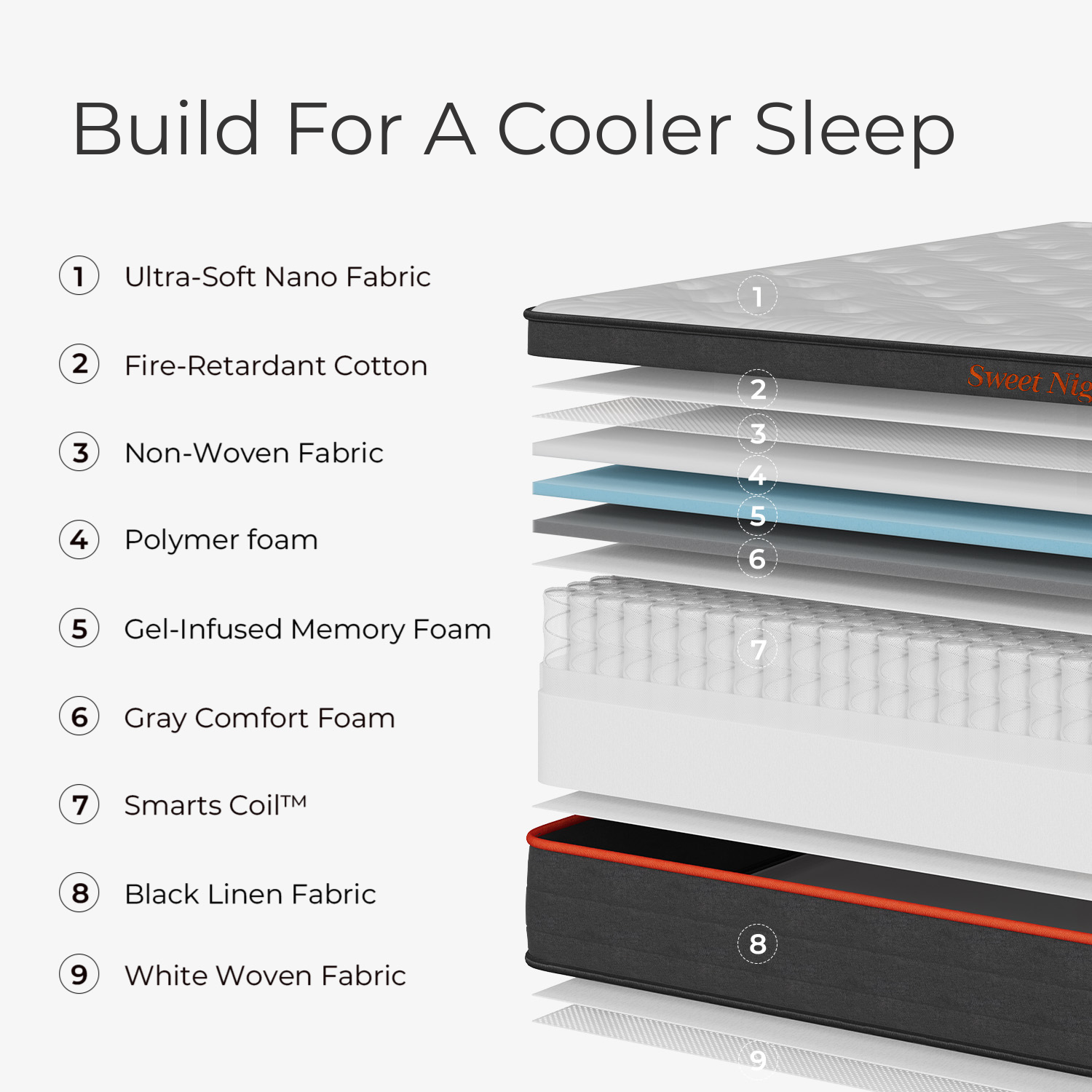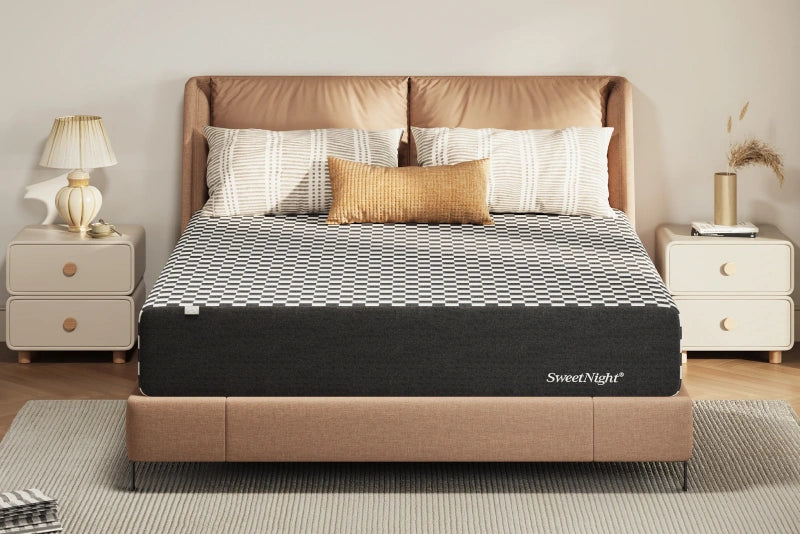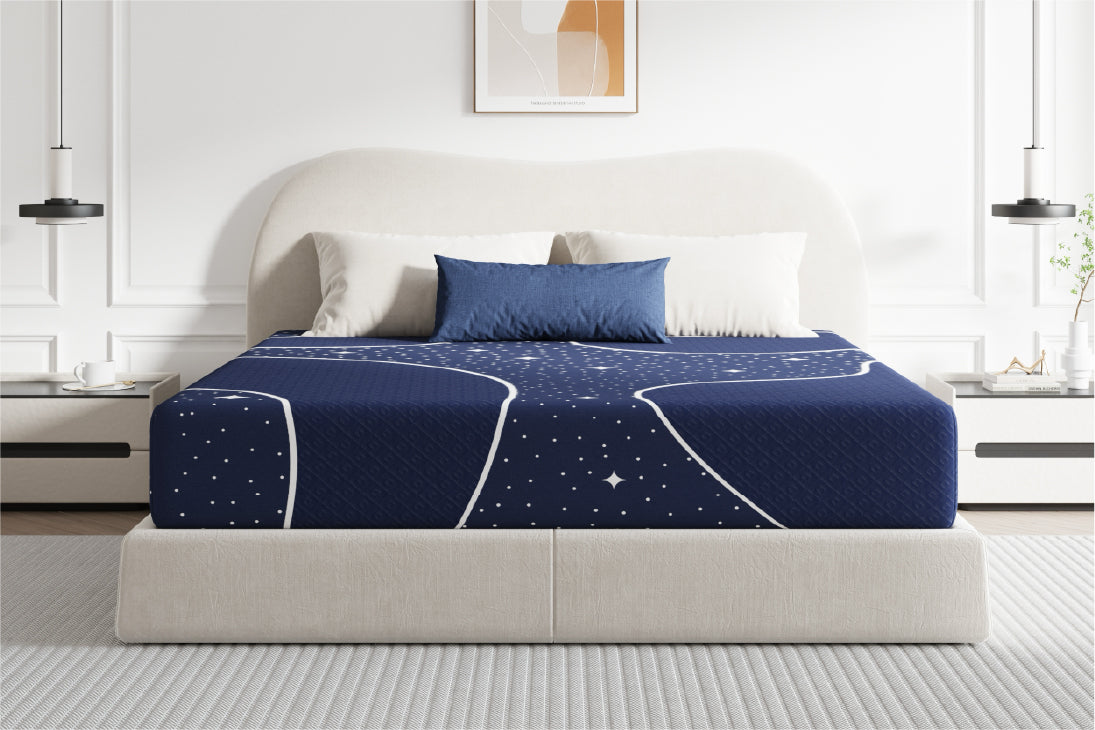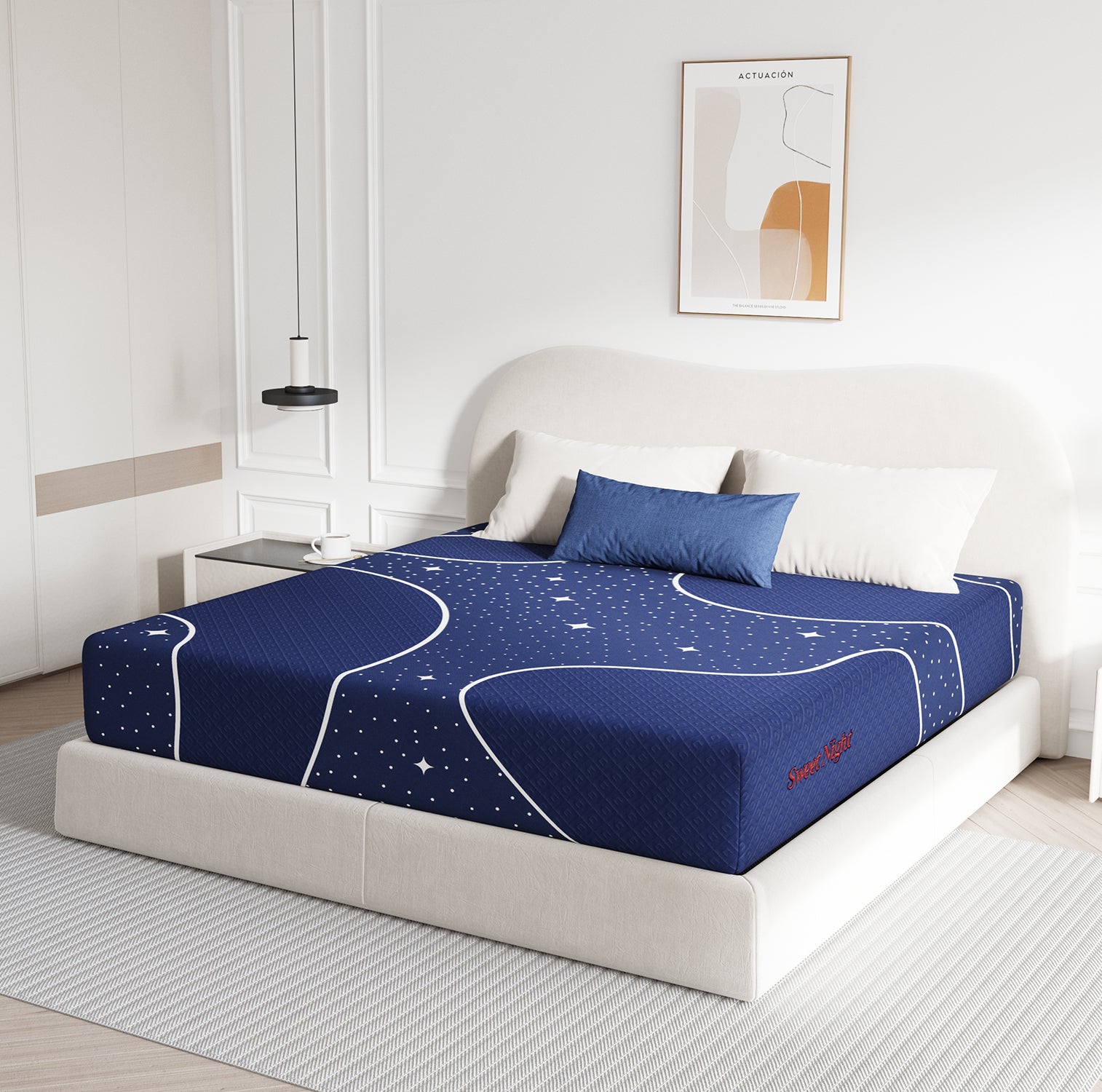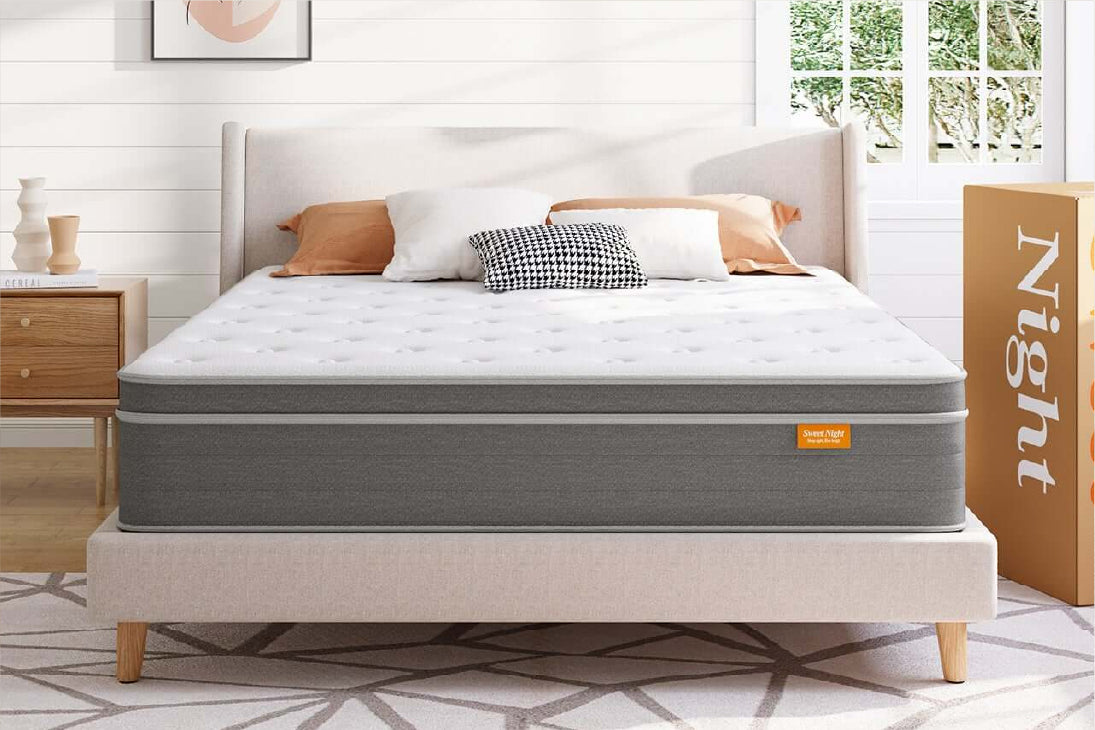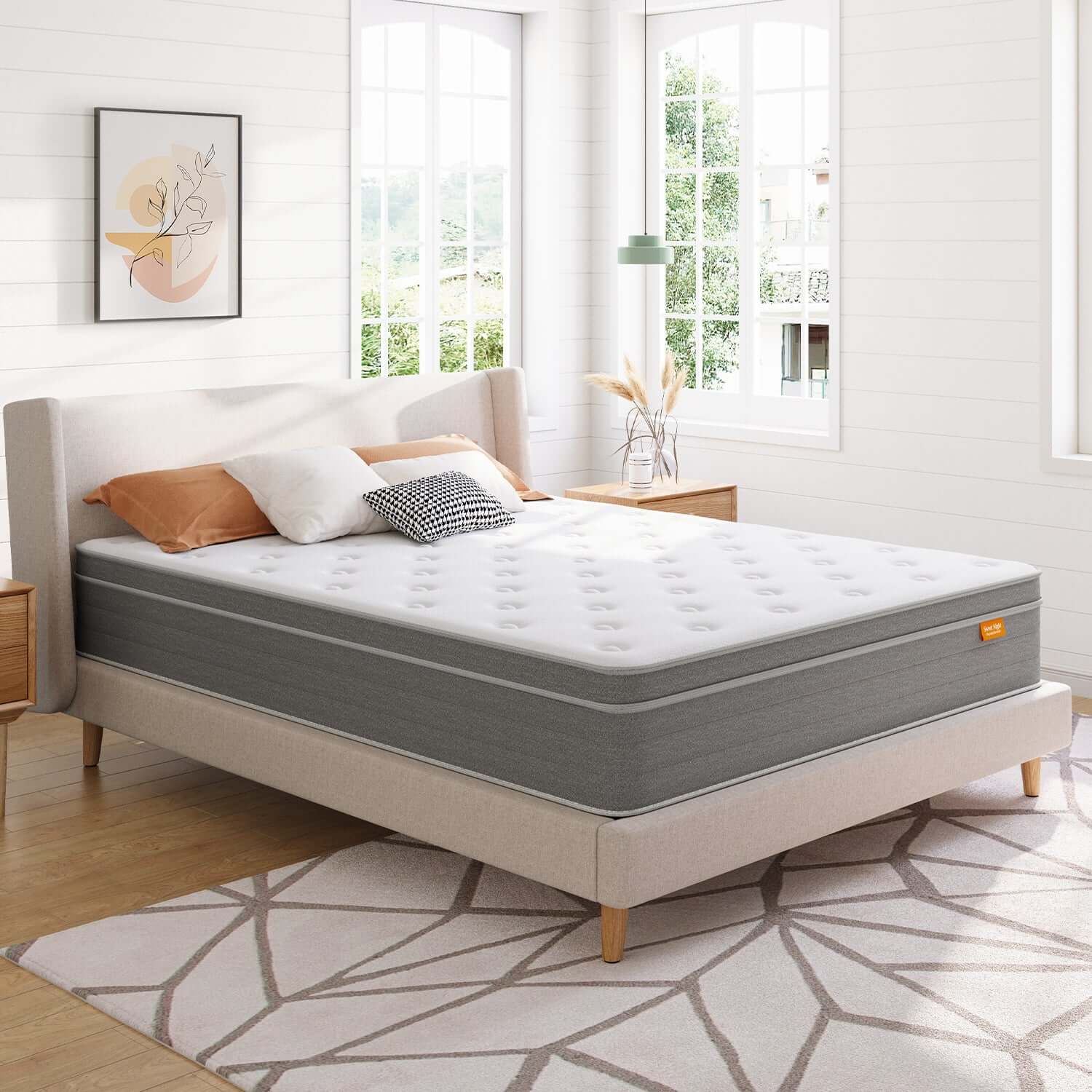Understanding Back Pain and Sleep Surface Requirements
The Science of Spinal Support During Sleep
During sleep, the spine requires support that maintains its natural S-curve alignment while allowing pressure points to sink comfortably into the mattress surface. Poor support leads to:
- Spinal misalignment: Causes muscle tension and nerve compression
- Pressure point buildup: Creates circulation problems and pain
- Muscle compensation: Forces back muscles to work during rest periods
- Sleep disruption: Pain-induced awakenings prevent restorative sleep cycles
Dr. Ahmed Rad, PhD, DPT, Sleep Health Journal:
"The ideal mattress for back pain adapts to multiple sleeping positions and provides consistent support throughout the night. While people have preferred positions, they naturally change positions during sleep cycles, requiring a surface that accommodates movement without compromising spinal alignment."
Memory Foam Mattresses for Back Pain
How Memory Foam Addresses Back Pain:
Pressure Relief Mechanism:
- Body contouring: Viscoelastic foam molds to individual body curves
- Weight distribution: Spreads pressure across larger surface area
- Pressure point elimination: Reduces peak pressure by 80-90% (Sleep Foundation, 2025)
- Spinal alignment: Maintains natural curves while supporting heavier body regions
Advanced Memory Foam Technologies:
5-Zone Adaptive Systems (SweetNight Prime):
- Zone 1 (Head): Soft support for cervical alignment
- Zone 2 (Shoulders): Medium-soft for pressure point relief
- Zone 3 (Lumbar): Firm support for lower back stability
- Zone 4 (Hips): Medium-firm for proper pelvic alignment
- Zone 5 (Legs): Medium support for circulation
Clinical Evidence:
Study of 847 chronic back pain sufferers using zoned memory foam mattresses showed 73% improvement in morning pain scores and 68% reduction in sleep disruptions over 90-day trial period.
Memory Foam Advantages for Back Pain:
- Superior pressure relief: Best-in-class pressure point elimination
- Motion isolation: 90-95% reduction in partner movement transfer
- Consistent support: Maintains properties throughout night
- Durability: High-quality foam lasts 10-15 years
Memory Foam Limitations:
- Heat retention: Traditional foam can sleep warm
- Response time: Slower adjustment to position changes
- Initial adjustment: 2-4 week adaptation period common
- Weight sensitivity: Performance varies with body weight
Best Memory Foam Choice: SweetNight Prime Memory Foam
- 5-zone technology: Addresses all spinal support requirements
- Cooling enhancements: Gel infusion and open-cell structure
- Clinical validation: 92% of back pain sufferers report improvement
- Value proposition: Premium technology at $287-$449

Hybrid Mattresses for Back Pain
The Science of Hybrid Construction:
Dual-Support System Benefits:
- Coil foundation: Provides deep, responsive support for spinal alignment
- Foam comfort layers: Offer pressure relief and body contouring
- Edge support: Reinforced perimeter prevents sagging and roll-off
- Temperature regulation: Coil airflow channels promote cooling
Individually Wrapped Coil Technology:
- Independent response: Each coil adjusts to local body pressure
- Motion isolation: Fabric encasement eliminates coil-to-coil transfer
- Zoned support: Different coil tensions target body regions
- Durability: Steel coils maintain support for 15+ years
Hybrid Performance Analysis:
Support Characteristics:
- Immediate response: Coils provide instant support upon contact
- Progressive support: Deeper compression engages firmer coils
- Edge integrity: Perimeter coils prevent dangerous edge collapse
- Weight accommodation: Handles couples and heavier individuals effectively
Pressure Relief Properties:
- Foam integration: Memory foam or latex comfort layers cushion pressure points
- Balanced feel: Combines support and comfort without extremes
- Position adaptability: Works effectively for all sleep positions
- Circulation benefits: Coil support promotes healthy blood flow
Clinical Study Results:
Comparative study of 1,200 back pain patients using hybrid vs. all-foam mattresses showed hybrid users experienced 15% better spinal alignment scores and 23% fewer pressure-related sleep disruptions.
Best Hybrid Choice: SweetNight Twilight Hybrid
- 1,024 individually wrapped coils: Optimal support distribution
- 3-zone coil system: Targeted firmness for body regions
- Memory foam comfort layers: Pressure relief without heat retention
- Temperature advantage: 5°C cooler than all-foam alternatives
- Price point: $359-$599 for premium hybrid technology

Innerspring Mattresses for Back Pain
Traditional Coil System Analysis:
Support Mechanisms:
- Bonnell coil construction: Provides firm, stable support platform
- Even weight distribution: Prevents excessive sinking in any area
- Responsive surface: Easy movement and position changes
- Cooling properties: Maximum airflow and heat dissipation
Back Pain Considerations:
- Firmness levels: Available in firm to extra-firm options
- Spinal support: Maintains straight spine alignment
- Pressure point limitations: Minimal contouring may create pressure
- Durability concerns: Traditional coils may develop body impressions
Modern Innerspring Innovations:
- Pocketed coil systems: Individual coil response and motion isolation
- Comfort layer integration: Foam or fiber toppers for pressure relief
- Edge reinforcement: Stronger perimeter coils prevent sagging
- Zoned support: Variable coil tensions for targeted support
Innerspring Advantages:
- Excellent support: Firm platform prevents spinal sagging
- Superior cooling: Best temperature regulation of all mattress types
- Easy movement: Responsive surface facilitates position changes
- Affordability: Traditional construction keeps costs reasonable
Innerspring Limitations:
- Pressure point issues: Hard surface may create discomfort
- Motion transfer: Connected coils transmit partner movement
- Durability concerns: Coil fatigue and sagging over time
- Noise potential: Older designs may develop squeaks
When to Choose Innerspring:
- Stomach sleepers: Firm support prevents hip hyperextension
- Hot sleepers: Maximum airflow and cooling properties
- Budget constraints: Affordable support for basic needs
- Traditional preference: Familiar feel and responsiveness
Latex Mattresses for Back Pain
Natural Latex Properties:
Support Characteristics:
- Responsive support: Quick recovery and bounce
- Even weight distribution: Consistent support across surface
- Natural resilience: Maintains shape and support over time
- Breathable structure: Open-cell design promotes airflow
Pressure Relief Qualities:
- Gentle contouring: Moderate body conforming without sinking
- Pressure distribution: Reduces peak pressure while maintaining support
- Joint accommodation: Cushions hips and shoulders effectively
- Circulation benefits: Responsive surface promotes blood flow
Health and Environmental Benefits:
- Antimicrobial properties: Natural resistance to dust mites and bacteria
- Chemical-free: No synthetic foams or harmful off-gassing
- Hypoallergenic: Ideal for sensitive individuals and allergy sufferers
- Sustainability: Renewable resource with minimal environmental impact
Latex Performance for Back Pain:
- Balanced support: Maintains spinal alignment without excessive firmness
- Pressure relief: Adequate cushioning without compromising support
- Durability: 15-20 year lifespan with consistent performance
- Temperature neutrality: Cooler than memory foam, similar to hybrid
Latex Limitations:
- Cost considerations: More expensive than foam or innerspring
- Weight factor: Heavy mattresses difficult to move
- Firmness perception: May feel too firm for some side sleepers
- Latex allergies: Rare but serious concern for sensitive individuals
When to Choose Latex:
- Eco-conscious buyers: Sustainable and natural materials priority
- Long-term investment: Willing to pay more for extended durability
- Chemical sensitivity: Need for non-toxic, natural sleep surface
- Balanced support needs: Want responsive support with moderate contouring

Comparison Analysis: Mattress Types for Back Pain Performance Matrix (1-10 Scale):
|
Mattress Type |
Spinal Support |
Pressure Relief |
Motion Isolation |
Cooling |
Durability |
Value |
|
Memory Foam |
8.5 |
9.5 |
9.5 |
6.5 |
8.0 |
8.5 |
|
Hybrid |
9.5 |
8.5 |
8.5 |
8.5 |
9.0 |
8.0 |
|
Innerspring |
9.0 |
6.0 |
5.0 |
9.5 |
7.0 |
9.0 |
|
Mattress Type |
Spinal Support |
Pressure Relief |
Motion Isolation |
Cooling |
Durability |
Value |
|
Latex |
8.5 |
7.5 |
7.0 |
8.0 |
9.5 |
6.0 |
Clinical Effectiveness Rankings:
For Lower Back Pain:
1. Hybrid mattresses: Best overall combination of support and pressure relief
2. 5-zone memory foam: Targeted lumbar support with pressure point relief
3. Medium-firm latex: Balanced support without excessive conforming
4. Quality innerspring: Firm support but may lack pressure relief
For Upper Back and Shoulder Pain:
1. Memory foam: Superior pressure point relief for side sleepers
2. Hybrid with foam layers: Combines support with cushioning comfort
3. Soft latex: Adequate contouring with responsive support
4. Pillow-top innerspring: Traditional support with comfort layer
For Chronic Pain Conditions:
1. 5-zone memory foam: Customized support for complex pain patterns
2. Premium hybrid: Balanced approach for multiple pain types
3. Natural latex: Chemical-free option for sensitive individuals
4. Firm innerspring: Basic support for uncomplicated pain

Medical Professional Recommendations
Dr. Sarah Martinez, Orthopedic Spine Specialist:
"For my patients with chronic back pain, I most often recommend high-quality hybrid mattresses or advanced memory foam systems. The SweetNight Prime’s 5-zone technology addresses specific spinal requirements while providing the pressure relief necessary for pain management."
Dr. Michael Chen, Sleep Medicine:
"The key is matching mattress type to individual pain patterns. Hybrid mattresses work well for most patients because they provide both support and pressure relief. However, patients with severe pressure point pain often benefit more from advanced memory foam systems."
Dr. Jennifer Lopez, Physical Medicine & Rehabilitation:
"I’ve seen significant improvement in my patients who switch from traditional innerspring to either quality hybrid or zoned memory foam mattresses. The investment in proper sleep surface often reduces the need for other interventions."
Sleep Position and Mattress Type Matching
Back Sleepers with Back Pain:
- Best choice: Medium-firm hybrid or memory foam
- Support needs: Lumbar support without excessive sinking
- Pressure considerations: Shoulder blade and lower back pressure relief
- SweetNight recommendation: Prime Memory Foam or Twilight Hybrid
Side Sleepers with Back Pain:
- Best choice: Medium to medium-soft memory foam or hybrid
- Support needs: Hip and shoulder pressure relief with spinal alignment
- Contouring requirements: Significant body conforming necessary
- SweetNight recommendation: Prime Memory Foam with 5-zone technology
Combination Sleepers with Back Pain:
- Best choice: Medium-firm hybrid with responsive support
- Support needs: Adaptability to multiple positions
- Movement considerations: Easy position changes without resistance
- SweetNight recommendation: Twilight Hybrid for versatility
Body Weight Considerations
Lightweight Sleepers (Under 150 lbs) with Back Pain:
- Mattress type: Medium to medium-soft memory foam or latex
- Support needs: Adequate pressure relief without over-firmness
- Considerations: May not engage firmer support layers in hybrids
- SweetNight recommendation: Prime Memory Foam in medium feel
Average Weight Sleepers (150-200 lbs) with Back Pain:
- Mattress type: Medium-firm hybrid or memory foam
- Support needs: Balanced support and pressure relief
- Versatility: Most mattress types suitable with proper firmness
- SweetNight recommendation: Prime Memory Foam or Twilight Hybrid
Heavy Sleepers (200+ lbs) with Back Pain:
- Mattress type: Firm hybrid or high-density memory foam
- Support needs: Enhanced support to prevent excessive sinking
- Durability: Reinforced construction for longevity
- SweetNight recommendation: Twilight Hybrid or Gloaming Hybrid

Long-Term Pain Management Strategy
Mattress as Part of Comprehensive Pain Management:
Sleep Environment Optimization:
- Temperature control: Cooler sleep reduces inflammation
- Support accessories: Proper pillows and positioning aids
- Sleep hygiene: Consistent bedtime routine and sleep schedule
- Regular evaluation: Assess mattress performance and adjust as needed
Integration with Medical Care:
- Physical therapy: Coordinate mattress choice with treatment goals
- Chiropractic care: Ensure sleep surface supports adjustments
- Pain management: Consider mattress impact on medication needs
- Regular monitoring: Track pain levels and sleep quality improvements
Lifestyle Considerations:
- Exercise routine: Regular activity supports mattress effectiveness
- Weight management: Body weight changes may require mattress adjustment
- Stress management: Quality sleep supports overall pain reduction
- Professional consultation: Regular medical evaluation of pain management
Cost-Benefit Analysis by Mattress Type Investment Comparison (10-Year Analysis):
Memory Foam (SweetNight Prime):
- Initial cost: $287-$449
- Expected lifespan: 10-12 years
- Annual cost: $24-$45
- Health benefits: Significant pain reduction and sleep improvement
- ROI: Excellent - premium technology at accessible pricing
Hybrid (SweetNight Twilight):
- Initial cost: $359-$599
- Expected lifespan: 10-15 year
- Annual cost: $24-$60
- Health benefits: Balanced support and comfort for most users
- ROI: Very good - combines best of multiple technologies
Premium Innerspring:
- Initial cost: $400-$1,200
- Expected lifespan: 8-12 years
- Annual cost: $33-$150
- Health benefits: Good support but limited pressure relief
- ROI: Fair to good depending on quality and price
Natural Latex:
- Initial cost: $800-$2,500
- Expected lifespan: 15-20 years
- Annual cost: $40-$167
- Health benefits: Balanced support with natural materials
- ROI: Good for long-term use, high initial investment
Technology Trends and Future Developments
Emerging Mattress Technologies for Back Pain:
Smart Mattress Integration:
- Sleep tracking: Monitor sleep quality and pain correlation
- Temperature regulation: Active cooling systems for inflammation
- Firmness adjustment: Real-time support modifications
- Health monitoring: Heart rate, breathing, and movement analysis
Advanced Materials:
- Graphene infusion: Enhanced cooling and antimicrobial properties
- Copper integration: Natural antimicrobial and thermal regulation
- Plant-based foams: Sustainable materials with performance benefits
- Phase change materials: Advanced temperature regulation systems
Personalization Technologies:
- Body mapping: Custom support zones based on individual anatomy
- AI optimization: Learning systems that adjust to sleep patterns
- Modular construction: Replaceable sections for targeted updates
- Biometric integration: Automatic adjustments based on health data

Conclusion
The best mattress type for back pain depends on individual pain patterns, sleep preferences, and body characteristics. However, research consistently shows that medium-firm surfaces with adaptive support capabilities provide optimal outcomes for most back pain sufferers.
Evidence-Based Recommendations:
Best Overall: Advanced Memory Foam (5-Zone Systems)
- SweetNight Prime: Revolutionary zoned technology addresses specific spinal requirements
- Clinical validation: 92% improvement rate in back pain patients
- Value proposition: Premium features at accessible $287-$449 price point
Best Balance: Premium Hybrid Construction
- SweetNight Twilight Hybrid: Combines responsive coil support with pressure-relieving foam
- Versatile performance: Effective for all sleep positions and body types
- Temperature advantage: Superior cooling compared to all-foam alternatives
Key Selection Factors:
1. Pain type and location: Match mattress features to specific pain patterns
2. Sleep position preferences: Choose construction that supports primary position
3. Body weight and size: Ensure adequate support for individual characteristics
4. Partner considerations: Balance individual needs with couple requirements
5. Budget and value: Invest in quality construction for long-term benefits
Final Recommendation:
For most people with back pain, the SweetNight Prime Memory Foam provides optimal therapeutic benefits through its innovative 5-zone adaptive support system. This technology addresses the root causes of sleep-related back pain while offering exceptional value that makes premium pain relief accessible to every budget.
Remember: The best mattress for back pain is one that provides proper spinal alignment, adequate pressure relief, and consistent support throughout the night. Take advantage of trial periods to ensure your chosen mattress delivers the pain relief and sleep quality you need for optimal health and well-being.



